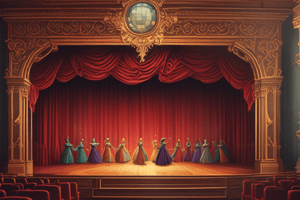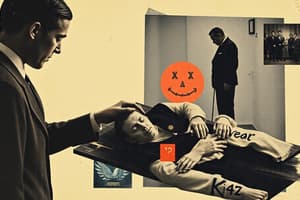Podcast
Questions and Answers
What is the main focus of picturization in directing for the stage?
What is the main focus of picturization in directing for the stage?
- Conveying subtext through actors' movements (correct)
- Linking scenes and emotions in diverse ways
- Creating harmony and chaos in the play
- Directing the flow of a play's events
Which aspect of directing involves conveying dramatic meaning through body language and blocking?
Which aspect of directing involves conveying dramatic meaning through body language and blocking?
- Rhythm
- Movement (correct)
- Composition
- Picturization
In directing, what does rhythm primarily refer to?
In directing, what does rhythm primarily refer to?
- Creating harmony in scenes
- The timing and pace of the play (correct)
- Supporting subtext with words
- Developing the emotional state of characters
What is the key role of a director in composition?
What is the key role of a director in composition?
Which element of directing involves telling a story through bodily and facial expressions rather than dialogue?
Which element of directing involves telling a story through bodily and facial expressions rather than dialogue?
What distinguishes pantomimic dramatization from other aspects of directing?
What distinguishes pantomimic dramatization from other aspects of directing?
Flashcards
Picturization in Directing
Picturization in Directing
Conveying the underlying or implicit meaning of a scene through the actors' physical actions and positioning on stage.
Movement in Directing
Movement in Directing
Communicating the dramatic intent and emotional subtext of a scene through actors' physical gestures, posture, and stage arrangement.
Rhythm in Directing
Rhythm in Directing
The manipulation of tempo, pauses, and flow within a play to enhance emotional impact and maintain audience engagement.
Composition in Directing
Composition in Directing
Signup and view all the flashcards
Pantomimic Dramatization
Pantomimic Dramatization
Signup and view all the flashcards
Pantomimic Dramatization
Pantomimic Dramatization
Signup and view all the flashcards
Study Notes
Course Overview
- This course focuses on the fundamental mechanics of directing for the stage
Composition in Directing
- Composition is the art of construction in a performance, linking scenes, word images, emotions, themes, light, and sound
- It involves combining and connecting diverse elements in a harmonious or chaotic way
- A director's role is to lead and subordinate these elements to create a cohesive performance
Picturization
- Picturization is the process of giving meaning to what the audience sees on stage
- It involves conveying subtext, which may or may not be supported by dialogue
- Picturization is achieved through the way actors move and occupy the stage
Movement in Performance
- Movement refers to the use of body, action, and blocking to convey dramatic meaning
- It involves the flow of action from one event to another in a performance
Rhythm in Performance
- Rhythm refers to the timing and pace of a performance
- It also involves the beat or tempo of the performance, which can vary throughout the drama
- Rhythm can be influenced by the emotional state of characters or the atmosphere of the performance
Pantomimic Dramatization
- Pantomimic dramatization is the process of telling a story through the expressive use of bodily or facial movements
- It involves acting a role without dialogue, relying on non-verbal cues to convey meaning
Studying That Suits You
Use AI to generate personalized quizzes and flashcards to suit your learning preferences.





